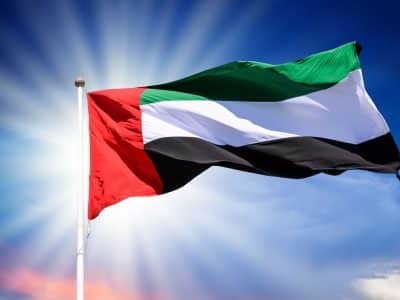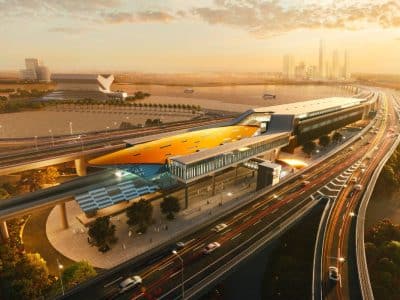Africa’s ports have made huge progress in recent years, with massive benefits being reaped through successful port management partnerships. Inclusion in Sea Freight Middle East’s Top Ten Ports is based not only on throughput but also on improvements and investment plans.
Durban, South Africa
Durban is Africa’s busiest general cargo port and home to one of the largest and busiest container terminals in the Southern Hemisphere. The port has a total of 59 effective berths excluding those used by fishing vessels and ship repair. A single buoy mooring at Isipingo caters for very large crude carriers (VLCC) that are too large to enter the port.
In response to demand the port of Durban is creating more container handling facilities including a second container terminal, but space will continue to be reserved for breakbulk and bulk cargo. The port has excellent rail and road links to neighbouring industrial zones and hinterland.
The largest ships to have entered Durban harbour are in the region of 230,000 dwt but even larger vessels are catered for in the outer anchorage. The port operates a fleet of tugs owned and operated by the National Ports Authority (NPA), which handle in excess of 800 ship movements each month.
Dredging is performed by the NPA on an ongoing basis in the port and immediately outside the entrance to counter the littoral drift that would otherwise recreate a sand bar across the entrance channel.
Durban has two floating cranes. Indlovu has a lifting capacity of 235 tonnes at 10m and 125t from 24m. The smaller Imvubu has a lifting capacity of 60 tonnes at 6.1m or 40.6t at 16.2m from the outboard edge.
The port of Durban handles the greatest volume of sea-going traffic of any port in southern Africa. For the 2005/06 financial year the port handled a total of 4551 sea-going ships with a gross tonnage of 94,543,236, which was equal to almost 36% of all ports combined.
Cargo handled amounted to 42,668,119 tonnes, which included oil and petroleum products. This tonnage however excludes containers, of which 1.956 million TEUs were handled in Durban last year, and may be calculated as the equivalent of 26,406,000 tonnes which, included with the gross figure above, gives the port a total tonnage of 69,074 million tonnes of cargo handled.
Total tonnage handled by the port (including the calculation for containers) constituted 43,584,358 tonnes of imports, 25,206,730 tonnes of exports and 283,371 tonnes of transhipment cargo.
Last year the combined Durban container terminals handled 1,955,803 TEUs. Containers handled at Durban represented 63% of the total number of containers handled at South African ports.
Extensive ship repair facilities consist of a graving dock divided by two compartments with a total length of 352.04m and a width of 33.52m at the top, split into an inner dock of 138.68m and an outer dock of 206.9m and serviced by up to five electric cranes from 50t to 10t. Bayhead has two general repair quays in addition to several privately operated and fully equipped repair facilities.The port also boasts two floating docks – one operated by the NPA with an overall length of 109m, a width of 23.34m and a displaced lifting capacity of 4500 tonnes, serviced by two 5-tonne capacity cranes. The second floating dock has a lifting capacity of 8500 tonnes.
Portof Richards Bay, South Africa
The Port of Richards Bay, the largest coal export terminal in the world, is located approximately 160km north-east of Durban and 465km south of Maputo, on the eastern seaboard of South Africa.
The establishment of the port 30 years ago has transformed a small fishing village into a dynamic industrial city, and a new berth has opened every second year.
To date the port has handled in excess of 1.3 billion tonnes of coal and a further 500 million tonnes of other raw materials and cargo.
The average throughput is over 80 million tonnes annually, which represents an impressive 60% of South Africa’s total seaborne cargo. There are five dedicated cargo-handling terminals at which approximately 1700 vessel calls are made each year. Port of Richards Bay has an entrance channel 300m wide with a permissible draft of 17.5m, and open storage for 6.7 million tonnes of coal.
The port boasts four bulk ship loaders and a massive 58km conveyor belt system on the stockyard side.
Major developments already underway include an additional bulk liquid handling berth and a ship repair facility. Container traffic for the hinterland is handled through the sister port in Durban, situated 160km south, however there is a project at preliminary design stage for a 50,000 TEUs container handling facility.
A massive US$140 million investment strategy to expand the coal terminal capacity to 92 million tonnes per annum is at an advanced stage.
Kenya, Mombasa
Kenya’s Indian Ocean port of Mombasa, serving Uganda, Rwanda, Burundi, and the eastern gateway for the Democratic Republic of Congo, is one of the most important ports in East Africa but struggles to cope with heavy throughput traffic. However, a rehabilitation programme is currently underway.
Kenya enjoys an extensive, if deteriorating, infrastructure. Mombasa is the best and most important deepwater port in the region, despite deteriorating equipment and problems with inefficiency and corruption.
The Port of Mombasa, with a rated annual capacity of 22 million tonnes, is Kenya’s main seaport and features 21 berths, two bulk oil jetties and dry bulk wharves that can handle modern deep draft ships.
The port offers specialised facilities, including cold storage, warehousing, and container terminals. Mombasa serves most international shipping lines and has an average annual freight throughput of about 8.1 million tonnes, of which 72% are imports.
The vast majority of Uganda’s exports and imports travel through this port. Inefficiency is a major issue, and transporting a container of goods between Mombasa and Kampala can take twice the time and expense as transporting that same container between London and Mombasa.Joseph Kibwana, chairman of Kenya Ports Authority (KPA) board of directors, has expressed confidence and optimism in his organisation’s capacity to deliver 420 moves per vessel per day.
KPA has prepared itself for this by installing new cargo handling equipment at Mombasa which has improved the rate of loading and off-loading. In a further bid to improve performance the KPA has undertaken a series of management courses and seminars for its employees with a view to changing attitude to work and customer service.
Dar Es Salaam, Tanzania
The principal sea port of Tanzania has a dedicated container terminal equipped with two ship-to-shore gantry cranes (SSG), each with a lifting a capacity of 35.6 tonnes. These are supported by six rubber tyred gantry cranes (RTG) for stacking containers in the yard.
The port benefits from being situated at the conversion of the two railway lines (Tanzania Railways and Tanzania Zambia Railways) serving the hinterland, and the international airport is located just 11km away. There is also an inland container depot located 2km outside the port.
The container terminal has three deep water berths with a current handling capacity of 200,000 TEUs per annum. Combined with general cargo and bulk liquids the facility handled over 5.5 million tonnes in 2006.
Port of Beira, Mozambique
The port of Beira in Mozambique is situated at the mouth of the Pungue River. The port is directly linked to the hinterland (Zimbabwe and Zambia) by road and rail networks, and currently by road only to Malawi.
However, the Sena railway line linking Beira with Malawi and the Tete Province is currently being rebuilt.
A pipeline constructed in 1960 links the port with Zimbabwe. Beira also has direct sea links to Europe, Asia and the Middle East. The facility at Beira has a total of 11 berths stretching over a total length of 1994 metres, excluding fishing berths.
Beira is 319km from the Zimbabwe border at Machipanda and 685km from Malawi via well-maintained road links. The port handles a variety of cargo from breakbulk, neo bulk and liquid bulk including petroleum.
Access to the port is obtained via the dredged Mancuti Channel.
Beira is served with two 2200BHP, 35 tonne bollard pull tugs, a pilot boat and a mooring launch, available 24 hours a day.
During 2005/6 a total of 208 ocean-going ships called at Beira, in addition to 80 coastal vessels. The container terminal handled 46,775 TEUs, which consisted of 240,333 tonnes landed, 240,669 tonnes shipped and 48,456 tonnes of coastal traffic.
General cargo handled consisted of 345,729 tonnes of cargo landed, 486,032 tonnes shipped and 6,019 tonnes of coastal general cargo. Total port throughput for the year amounted to 1,367,238 tonnes.Beira’s facilities include a container terminal and a general cargo terminal, both of which are concessioned to Cornelder de Moçambique. The port also has a specialised liquid bulk facility.
The multi-purpose and container terminal is one of the most modern in southern Africa and covers 645 metres of berth length with a depth alongside of 12 metres. The terminal design capacity is 100,000 TEUs per year.
The port is served by an illuminated container yard spread over 200,000m2, accommodating 3,117 TEUs including 144 electrical reefer points and dedicated IMDG (International Maritime Dangerous Goods) storage area, and a fully secured 3650m2 covered storage facility.
All activities at Beira are fully computerised utilising a port management system, which can be accessed by the internet to provide accurate information on the status of their cargo.
The port is equipped with two 50 tonne ship-to-shore gantry cranes, a fleet of reachstackers and one rail mounted gantry crane with a 50 tonnes capacity.
There is a dedicated refrigerated cargo berth including citrus exports, vegetables and other fresh products.
Djibouti
DP World secured the management contract for Djibouti Port in June 2000. A 20 year concession provides long-term commitment from DP World to the development of the port at Djibouti. The links with the Middle East are further enhanced as Djibouti Free Zone (DFZ) is managed by Dubai’s JAFZA.
With a capacity area of 17 ha, DFZ serves 39 national and multinational companies and will accommodate more when fully operational. Djibouti lies on the main east-west trade route with minimal journey deviation, and provides a secure hub within the region for transhipment and relay business.
Djibouti serves as a primary gateway for the strong transit trade to Ethiopia, being the only port in the region connected to the Ethiopian capital by rail. The terminal currently has a container handling capacity of 350,000 TEUs per annum.
Since 2001 Djibouti Port’s container productivity has doubled to 28 moves per hour making it one of the best performers in Africa. Djibouti has proven its ability to adapt at short notice to significant volume increases and the government has committed to extend the current port capacity.
Djibouti’s ability to challenge as a major transhipment hub will receive a significant boost with the completion of the US$400 million specialised container terminal at nearby Doraleh, scheduled for 2008.
The container terminal will have a quay length of 1050m, 18m water depth with capacity of 1.5 million TEUs in the first phase, and will be expanded to 2000m in the second phase with a projected capacity of three million TEUs.
Suez Canal Container Terminal, Egypt
A state-of-the-art facility has emerged at Port Said East as a transhipment centre serving the Mediterranean at the northern entrance to the Suez Canal.The facility is ideally located at the entrance of Suez, which allows for zero deviation of vessels catering to European trade from the Middle East, Asia and East Africa.
The container terminal is one of the newest in the whole of Africa, having begun operations in 2004, and its inclusion in the Top Ten African Ports is warranted on the back of its outstanding development rate.
SCCT became the first Egyptian port to feature 12 super post-Panamax cranes and in its first full year of operations the port handled 700,000 TEUs. The one million TEUs mark was passed within the first 18 months of operation.
The quay wall extends to 1,200m and the terminal has accommodation space for 47,500 containers, including 976 allocated reefer slots. An expansion plan is already underway, which will double the terminal size by 2009.
Recently the port has achieved impressive productivity figures, setting a national record of 47.6 moves per hour in January 2007. A total of 1482 container moves were accomplished in just one day.
Lagos, Nigeria
The Port of Lagos is Nigeria’s primary seaport and is split into three main divisions: Lagos Port, Apapa Port and Tin Can Port, all located on the Gulf of Guinea and operated by the Nigerian Port Authority.
Lagos handles significant trade from neighbouring Benin, Niger and Cameroon. Nigeria itself is home to 140 million people, making it the largest single market on the continent.
The terminal handles imports of consumer goods, foodstuffs, motor vehicles, machinery, and industrial raw materials for Africa’s most populous nation. Despite declining export trade in timber and agricultural products, such as cacao and groundnuts since the early 1970s, the port has handled growing crude oil exports.
The increasing importance of oil and petroleum products to the Nigerian economy has helped compensate for the raw material decline, with the hydrocarbon sector accounting for 20% of GDP, and a massive 95% of foreign exchange earnings for Nigeria as a whole.
The port is the western terminus of the nation’s road and railway networks, and the airport at Ikeja provides local and international services.
The inauguration by former President Obasanjo of the Calabar Export Processing Zone (EPZ) has helped to promote the diversification of the export base.
The Calabar zone has been designated as the primary EPZ territory and a total of 80 serviced plots have been reserved for prospective investors for self-built factories.
In an encouraging nod to the future of the industry, a new maritime transport academy, based in Lagos, was announced in December 2006.
Walvis Bay, Namibia
Walvis Bay is the principal port of Namibia and is situated on the west coast of southern Africa. The port has a concrete quay of 1400 metres and the channel and waters alongside berths 1, 2 and 3 have been dredged to 12.8 metres, with berth 4 deepened to 10.6 metres.Walvis Bay is a general cargo port and is being aggressively marketed as an alternate port of choice to South African ports further south and east. There are good road and rail connections with the rest of Namibia while the Trans Kalahari Corridor links the port with Botswana and Gauteng province in South Africa.
The port currently handles in excess of two million tonnes of cargo annually and is attracting a greater number of shipping lines as regular callers. These include Unicorn Lines which provides a weekly coaster service with South Africa, and Maersk, Safmarine and MACS Line, which provide connections or direct sailing to Europe.
The port has a total of nine berths excluding facilities for small craft and fishing vessels. Walvis Bay maintains a fleet of two Azimuth-propelled harbour tugs of 23 tonnes and 28t bollard pull.
An average of 1000 ships call at Walvis Bay each year. The current handling capacity is rated at 5 million tonnes. There is also a dolphin type tanker berth catering for tankers up to 192 metres in length and a maximum 10 metre draught.
The container terminal consists of nearly 400 ground slots with 210 reefer points. Cargo is handled either by ships own gear or using the harbour’s mobile crane. Bunkering is available at five berths by pipeline and other berths via road transport.
Ship repair facilities include a synchrolift capable of lifting 2,000 tonnes vessels with a maximum length of 80m.
Saldanha Bay, South Africa
The Port of Saldanha Bay was purpose built for iron ore exports in the early 1970s, however the port has significantly diversified its commodity base over the last three decades.
Additional liquid bulk and general cargo quay facilities have been provided to handle the following commodities: crude oil, steel coils, granite, and concentrates.
Saldanha Bay is a natural deepwater port and has a permissable alongside draft of 21.5 metres. Throughput volumes for 2005/6 include 28.4 million tonnes of iron ore handled at the dry bulk terminal, 6.1 million tonnes of crude oil from the liquid bulk terminal, and a further 2.2 million tonnes of general cargo.
The iron ore export facilities in the port are currently being upgraded to handle up to 39 million tonnes per annum, and the work is estimated to be completed this year. Also envisaged are further upgrades to increase the capacity of the existing facilities to a port total of 45 mtpa export by 2008.
New infrastructure to further increase the handling capacity over the next five years is currently at feasibility stage analysis.
The offshore oil and gas initiative in the Western Cape region has got off to a flying start with the commencement of site establishment facilities at the 22 hectare Mossgas site in Saldanha.
The operator aims to have the facilities in place by August 2007 after which it will actively pursue fabrication work within the oil and gas arena.
The facility is targeted to serve this developing industry in South Africa by fabrication of components for offshore structures. Already under construction are roadways, high shot-blast sheds, and secure storage areas.







